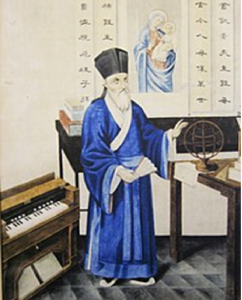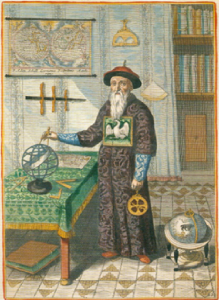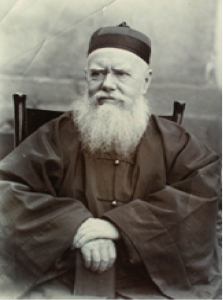4. Christianity in China
The history of Christianity in China dates back to ancient times. According to Christian tradition, Thomas (the “Apostle to India”) is believed to have been the first to bring the Gospel of Christ to China. However, the earliest documented historical records showed that Persian Nestorian missionaries introduced Christianity to China in 635 AD in the Tang Dynasty. Accounts of the introduction of Roman Catholicism appear in the 13th century during the Yuan Dynasty (1271 AD – 1368 AD). Russian Orthodox Christianity entered China in the late 17th century as part of the expansion of the Russian Empire eastward. The history of Protestant Christianity in China began with the arrival of British missionary Robert Morrison in the early 19th century. According to date in Chinese government website, suggestion that the number of Chinese Christians reached approximately 23 million.
Famous Western Missionaries in China

An early 17th-century depiction of Ricci in Chinese Robes.
Matteo Ricci[1] (利玛窦Lì Mǎdòu, 1552-1610) was an Italian Jesuit priest and the first great Jesuit China missionary (in China 1583-1610). Ricci arrived in China in 1583 and mastered the Chinese language and writing system. In 1584, he composed the first European-style world map in Chinese (大瀛全图Complete Map of the Great World). He also participated in compiling a Portuguese-Chinese dictionary, the first in any European language. In recognition of his scientific abilities, his predications of solar eclipses, Ricci, in 1601, was invited to become an adviser to the imperial court of the Wani Emperor of Ming Dynasty (1368 – 1644) and became the first Westerner to enter the Forbidden City of Beijing. Later he established the oldest Catholic church in Beijing. During his stay in Beijing, he preached the gospel and converted some important official to Christianity, including well-known Chinese agronomist Xu Guangqi. He was also the first Westerner to reside permanently in China and played a significant role in bridging Chinese and Western cultures. After his death, he was honored by the Ming emperor and was allowed to be buried in Beijing in the light of his contributions to China.

A portrait of Johann Adam Schall von Bell
Johann Adam Schall von Bell[2] (汤若望 Tāng Ruòwàng, 1592 – 1666) was a German Jesuit who has lived in China for 47 years, spanning the Ming and Qing dynasties. He was one of the most important Jesuit missionaries to China after Matteo Ricci. In 1618, Schall von Bell arrived in Macau in 1620 and went to Beijing in 1630 to modify the Chinese calendar and compile “Chongzhen Calendar” with Xu Guangqi. The completion of this calendar marked the integration of Chinese astronomy into the global development of astronomy. In order to gain the legal status of Catholicism in various provinces in China, in 1638, he petitioned Chongzhen Emperor to confer a plaque to hang in the Catholic churches in China. After entering the Qing dynasty (1644 – 1912), Schall von Bell received the trust from the Qing court and served as counsellor to Shunzhi Emperor. In 1645, he condensed the “Chongzhen Calendar” into the “Western New Method Calendar” and presented it to the Qing court. With the inscription “According to Western New Methods” on its cover, this calendar was renamed by the Qing court as the “Shixian Calendar” and promulgated across the country. It became the basis for China’s lunar calendar. Schall von Bell was officially appointed as the Director of the Imperial Observatory and turned to be the first foreigner to hold such a position, initiating a tradition of Jesuit oversight for nearly two centuries. Due to the favor that he received from the court, the Catholicism was spread fast and smoothly in China at that time. Till 1650, more than 150,000 Chinese have been baptized by Jesuit missionaries.
[2] https://en.wikipedia.org/wiki/Johann_Adam_Schall_von_Bell

A portrait of James Hudson Taylor
James Hudson Taylor [3] (戴德生Dài Déshēng, 1832 – 1905) was a British Baptist Christan missionary to China and founder of the China Inland Mission (CIM). He spent 54 years in China and devoted his entire life to the gospel work in China. When he was young, the book China: Its State and Prospects inspired him to study Mandarin Chinese and come to China to preach the gospel. He went to China in 1850 and in 1865 founded the Chinese Inland Mission, which was a “faith mission” (that is, no finances guaranteed, and no real budget; all confidence was place in God’s provision”. Applying the non-urban strategy, CIM seek to penetrate the countryside and unreached places. It was the first mission to adopt the practice of wearing native dress as a general policy. CIM started 125 schools, directly resulted in 20,000 Christian conversions, and established more than 300 stations of work in all 18 provinces in China. Taylor’s system and his personal charisma increased the CIM to 322 missionaries in 1888 and 825 in 1905 and made the CIM three times larger than the next largest group, the British Church Missionary Society.

